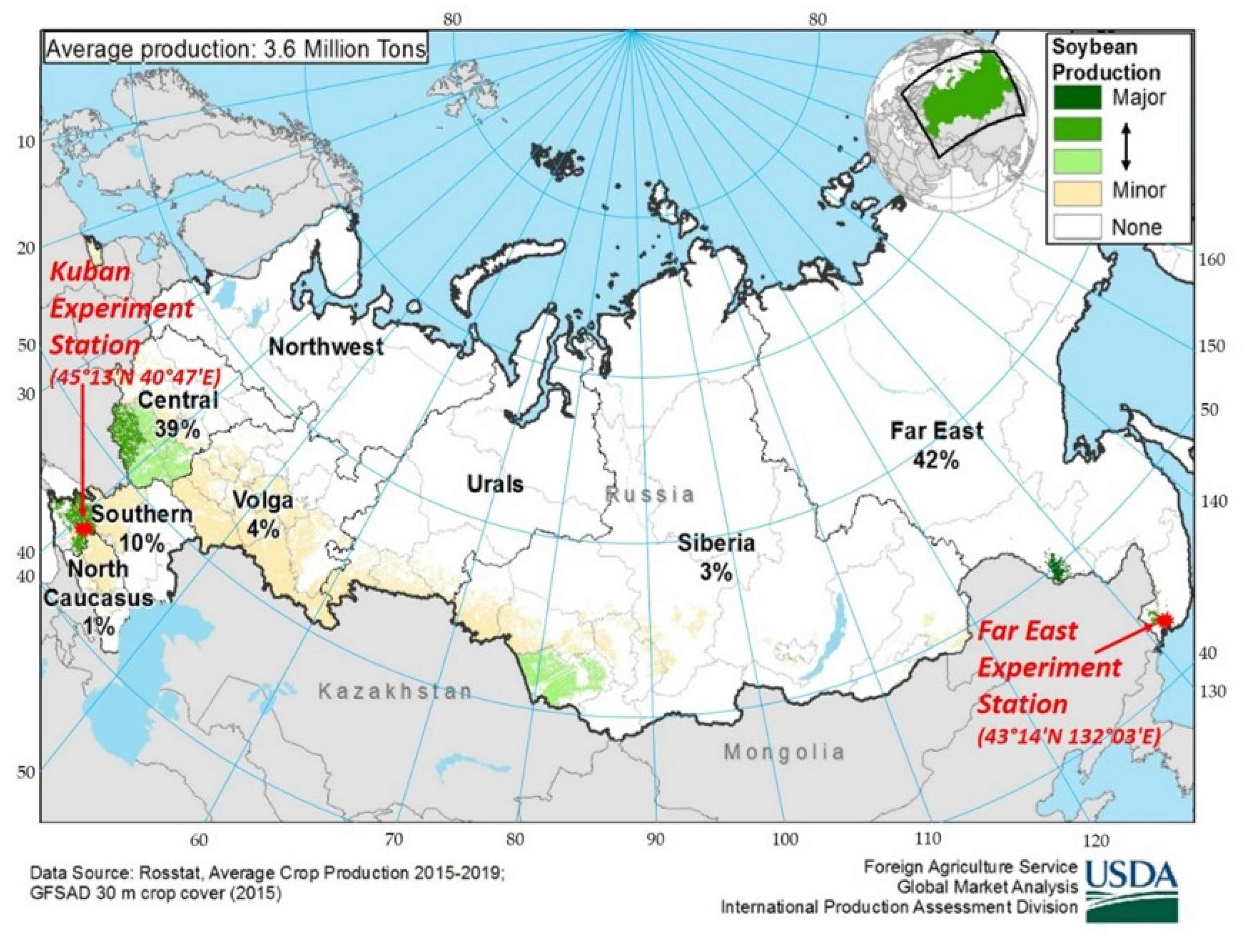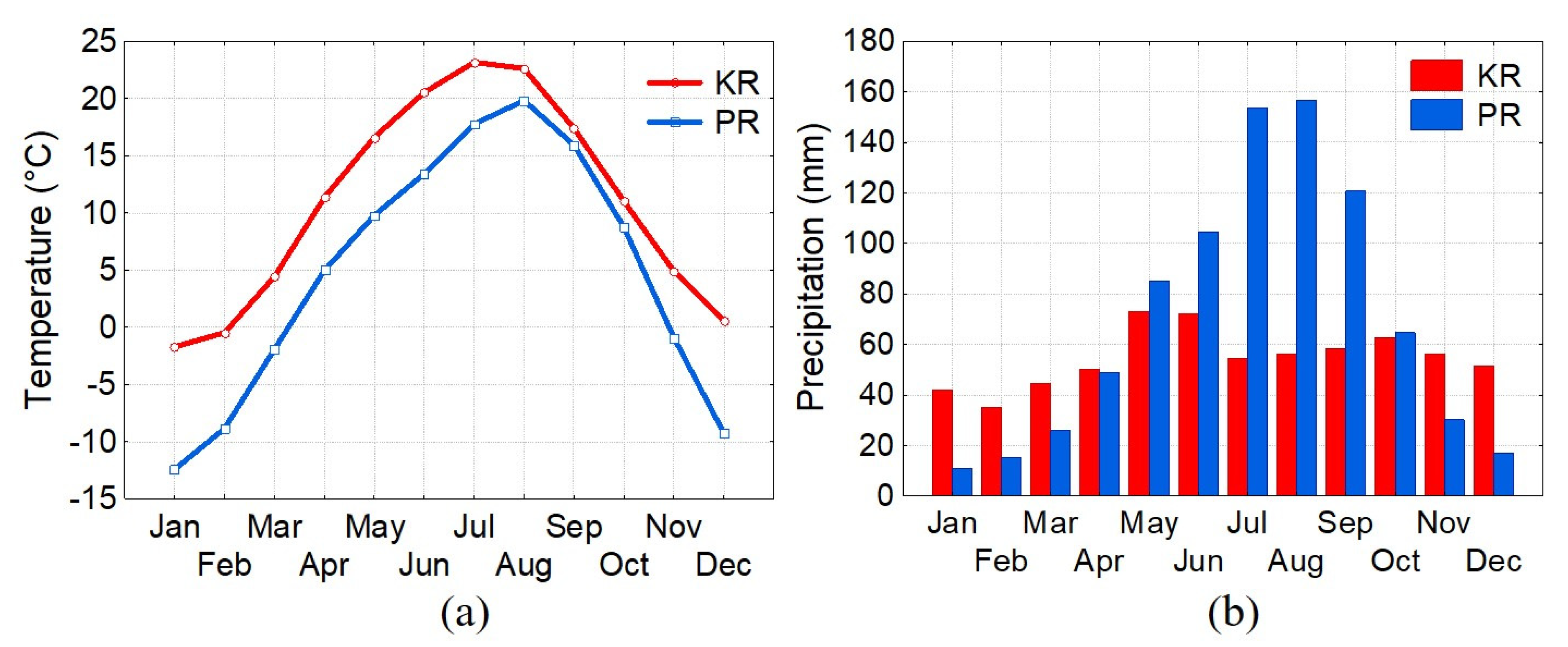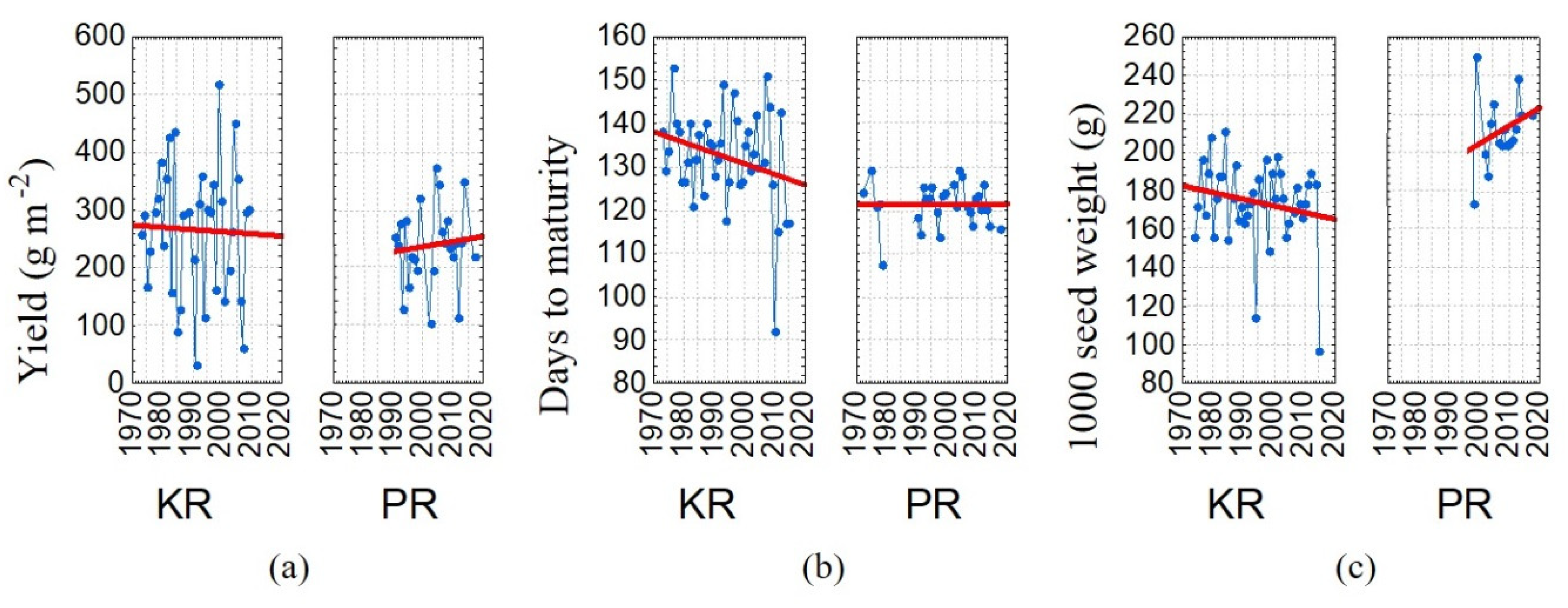Soybean Response to Weather and Climate Conditions in the Krasnodar and Primorye Territories of Russia over the Past Decades
Abstract
1. Introduction
2. Materials and Methods
2.1. Sites Description and Materials
2.2. Data Analysis
2.3. Climatic Conditions
3. Results
3.1. Comparison of Soybean Characteristics in KR and PR
3.2. Specificity of the Reaction of Different Maturity Groups
3.3. Agrometeorological Regression Models of Crop Yields in KR and PR
4. Discussion
5. Conclusions
Supplementary Materials
Author Contributions
Funding
Acknowledgments
Conflicts of Interest
References
- Lobell, D.B.; Asner, G.P. Climate and management contributions to recent trends in US agricultural yields. Science 2003, 299, 1032. [Google Scholar] [CrossRef] [PubMed]
- Wenjiao, S.; Fulu, T.; Zhao, Z. A review on statistical models for identifying climate contributions to crop yields. J. Geogr. Sci. 2013, 23, 567–576. [Google Scholar]
- Iizumi, T.; Ramankutty, N. Changes in yield variability of major crops for 1981–2010 explained by climate change. Environ. Res. Lett. 2016, 11, 034003. [Google Scholar] [CrossRef]
- Zhao, C.; Liu, B.; Piao, S.; Wang, X.; Lobell, D.B.; Huang, Y.; Huang, M.; Yao, Y.; Bassu, S.; Ciais, P.; et al. Temperature increase reduces global yields of major crops in four independent estimates. Proc. Natl. Acad. Sci. USA 2017, 114, 9326–9331. [Google Scholar] [CrossRef]
- Kim, Y.-U.; Choi, D.-H.; Ban, H.-Y.; Seo, B.-S.; Kim, J.; Lee, B.-W. Temporal patterns of flowering and pod set of determinate soybean in response to high temperature. Agronomy 2020, 10, 414. [Google Scholar] [CrossRef]
- Calvino, P.A.; Sadras, V.O. Interannual variation in soybean yield: Interaction among rainfall, soil depth and crop management. Field Crop. Res. 1999, 63, 237–246. [Google Scholar] [CrossRef]
- Zolotnitsky, V.A. Soybean in the Far East; Khabarovsk Book Publishing House: Khabarovsk, Russia, 1962. [Google Scholar]
- Zelentsov, S.V.; Moshnenko, E.V. Ways of adaptation of Russian agriculture to global climatic changes on the example of soybean ecological breeding. Sci. Dialogue 2012, 7, 40–59. [Google Scholar]
- Zaytsev, N.I.; Bochkaryov, N.I.; Zelentsov, S.V. Prospects and directions for soybean breeding in Russia under implementation conditions of the national strategy of import substitution. Oil Crops. Sci. Tech. Bull. VNIIMK 2016, 2, 3–11. [Google Scholar]
- Federal State Statistics Service (Rosstat). Available online: www.gks.ru (accessed on 30 May 2020).
- United States department of Agriculture. Foreign Agricultural Service. Available online: https://ipad.fas.usda.gov (accessed on 4 August 2020).
- Enken, V.B. Soybean; Sel’khozgiz: Moscow, Russia, 1959. [Google Scholar]
- Choi, D.-H.; Ban, H.-Y.; Seo, B.-S.; Lee, K.-J.; Lee, B.-W. Phenology and Seed Yield Performance of Determinate Soybean Cultivars Grown at Elevated Temperatures in a Temperate Region. PLoS ONE 2016, 11, e0165977. [Google Scholar] [CrossRef]
- Allen, L.H.; Zhang, L.; Boote, K.J.; Hauser, B.A. Elevated temperature intensity, timing, and duration of exposure affect soybean internode elongation, mainstem node number, and pod number per plant. Crop. J. 2018, 6, 148–161. [Google Scholar] [CrossRef]
- Purcell, L.C.; Salmeron, M.; Ashlock, L. Soybean growth and development. In Arkansas Soybean Handbook; University of Arkansas: Fayetteville, AR, USA, 2014; Available online: www.uaex.edu/publications/pdf/mp197/chapter2.pdf (accessed on 30 May 2020).
- Major, D.J.; Johnson, D.R.; Tanner, J.W.; Anderson, I.C. Effects of daylength and temperature on soybean development. Crop. Sci. 1975, 15, 174–179. [Google Scholar] [CrossRef]
- Chen, L.; Cai, Y.; Qu, M.; Wang, L.; Sun, H.; Jiang, B.; Wu, T.; Liu, L.; Sun, S.; Wu, C.; et al. Soybean adaption to high-latitude regions is associated with natural variations of GmFT2b, an ortholog of FLOWERING LOCUS T. Plant Cell Environ. 2020, 43, 934–944. [Google Scholar] [CrossRef]
- Li-xin, Z.; Wei, L.; Tsegaw, M.; Xin, X.; Yan-ping, Q.; Sapey, E.; Lu-ping, L.; Ting-ting, W.; Shi, S.; Tian-fu, H. Principles and practices of the photo-thermal adaptability improvement in soybean. J. Integr. Agric. 2020, 19, 295–310. [Google Scholar] [CrossRef]
- Setiyono, T.D.; Weiss, A.; Specht, J.E.; Bastidas, A.M.; Cassman, K.G.; Dobermann, A. Understanding and modeling the effect of temperature and daylength on soybean phenology under high-yield conditions. Agron. Hortic. Fac. Publ. 2007, 112, 1–17. Available online: http://digitalcommons.unl.edu/agronomyfacpub/112 (accessed on 27 April 2020). [CrossRef]
- Stepanova, V.M. Climate and Variety: Soybean; Gidrometeoizdat: Leningrad, Russia, 1985; 183p. (In Russian) [Google Scholar]
- Hodges, T.; French, V. Soybean: Soybean stages modeled from temperature, daylenth and water availability. Agron. J. 1985, 77, 500–505. [Google Scholar] [CrossRef]
- Pedersen, P.; Boote, K.J.; Jones, J.W.; Lauer, J.G. Modifying the CROPGRO-Soybean Model to Improve Predictions for the Upper Midwest. Agron. J. 2004, 96, 556–564. [Google Scholar] [CrossRef]
- Tacarindua, C.R.P.; Shiraiwa, T.; Homma, K.; Kumagai, E.; Sameshima, R. The effects of increased temperature on crop growth and yield of soybean grown in a temperature gradient chamber. Field Crop. Res. 2013, 154, 74–81. [Google Scholar] [CrossRef]
- Penalba, O.C.; Bettolli, M.L.; Vargas, W.M. The impact of climate variability on soybean yields in Argentina. Multivariate regression. Meteorol. Appl. 2007, 14, 3–14. [Google Scholar] [CrossRef]
- Gao, X.-B.; Guo, C.; Li, F.-M.; Li, M.; He, J. High soybean yield and drought adaptation being associated with canopy architecture, water uptake, and root traits. Agronomy 2020, 10, 608. [Google Scholar] [CrossRef]
- Stepanova, V.M. Agroclimatic assessment of soybean cultivation in the USSR. In Agro-Climatic Resources of Natural Zones of the USSR and Their Use; Hydrometeorological Publishing House: Leningrad, Russia, 1970; pp. 39–47. (In Russian) [Google Scholar]
- Richardson, A.D.; Anderson, R.S.; Arain, M.A.; Barr, A.G.; Bohrer, G.; Chen, G.; Chen, J.M.; Ciais, P.; Davis, K.J.; Desai, A.R.; et al. Terrestrial biosphere models need better representation of vegetation phenology: Results from the North American Carbon Program Site Synthesis. Glob. Chang. Biol. 2012, 18, 566–584. [Google Scholar] [CrossRef]
- Iler, A.M.; Inouye, D.W.; Schmidt, N.M.; Høye, T.T. Detrending phenological time series improves climate–phenology analyses and reveals evidence of plasticity. Ecology 2017, 98, 647–655. [Google Scholar] [CrossRef] [PubMed]
- Seferova, I.V.; Novikova, L.Y.; Nekrasov, A.Y. Estimation of soybean cultivar Komsomolka reaction on climate changes in Krasnodar region. Oil Crop. Sci. Tech. Bull. VNIIMK 2011, 1, 72–77. (In Russian) [Google Scholar]
- Novikova, L.Y.; Seferova, I.V.; Kozlov, K.N. Model Parameterization: The Timing of Flowering in Soybean Accessions. Biophysics (Russ. Fed.) 2018, 63, 956–958. [Google Scholar] [CrossRef]
- Kozlov, K.N.; Novikova, L.Y.; Seferova, I.V.; Samsonova, M.G. A Mathematical Model of the Effect of Climatic Factors on Soybean Development. Biophysics (Russ. Fed.) 2018, 63, 136–137. [Google Scholar] [CrossRef]
- Forkman, F.J. Coefficients of Variation—An Approximate F-Test. Licentiate Thesis, Swedish University of Agricultural Sciences, Uppsala, Sweden, 2005; 63p. [Google Scholar]
- RIHMI-World Data Center. Available online: www.meteo.ru (accessed on 26 September 2019).
- Loskutov, I.G. Vavilov and His Institute. A History of the World Collection of Plant Genetic Resources in Russia; International Plant Genetic Resources Institute (IPGRI): Rome, Italy, 1999. [Google Scholar]
- Waqas, L.; Muhammad, F.J.; Haseeb, A.; Muhammad, D.A. Genotype and Environment Interaction Determines the Yield Potential of a Crop under Changing Climate. Int. J. Environ. Sci. Nat. Res. 2018, 9, 73–75. [Google Scholar] [CrossRef]
- Loskutov, I.G.; Novikova, L.Y.; Kovaleva, O.N.; Ivanova, N.N.; Blinova, E.V.; Belskaya, G.V. Ecological-geographic approaches to the study of genetic diversity of barley and oat from the VIR collection. Ecol. Genet. 2020, 8, 89–102. [Google Scholar] [CrossRef]
- IPCC. Summary for Policymakers. In Global Warming of 1.5 °C; World Meteorological Organization: Geneva, Switzerland, 2018; Available online: https://www.ipcc.ch/sr15 (accessed on 26 March 2020).
- Liu, H.R.; Sun, G.W.; Dong, L.J.; Yang, L.Q.; Yu, S.N.; Zhang, S.L.; Liu, J.F. Physiological and molecular responses to drought and salinity in soybean. Biol. Plant 2017, 61, 557–564. [Google Scholar] [CrossRef]
- De Castro, J.N.; Müller, C.; Almeida, G.M.; Costa, A.C. Physiological tolerance to drought under high temperature in soybean cultivars. Aust. J. Crop Sci. 2019, 13, 976–987. [Google Scholar] [CrossRef]
- Sloat, L.L.; Davis, S.J.; Gerber, J.S.; Moore, F.C.; Ray, D.K.; West, P.C.; Mueller, N.D. Climate adaptation by crop migration. Nat. Commun. 2020, 11, 1–9. [Google Scholar] [CrossRef]
- Ahmadi, N.; Bertrand, B.; Glaszmann, J.C. Rethinking Plant Breeding. In Cultivating Biodiversity to Transform Agriculture; Hainzelin, É., Ed.; Springer: Dordrecht, Germany, 2013. [Google Scholar] [CrossRef]
- SoyStats. Available online: http://soystats.com (accessed on 4 August 2020).
- Magugu, J.W.; Feng, S.; Huang, Q.; Luthra, K. Impact of Climate Variations on Soybean Yield in Eastern Arkansas: 1960–2014. J. Ark. Acad. Sci. 2016, 70, 24. Available online: https://scholarworks.uark.edu/jaas/vol70/iss1/24 (accessed on 5 August 2020).
- Eulenstein, F.; Lana, M.; Schlindwein, S.; Sheudzhen, A.; Tauschke, M.; Behrend, A.; Guevara, E.; Meira, S. Trends of Soybean Yields under Climate Change Scenarios. Horticulturae 2017, 3, 10. [Google Scholar] [CrossRef]
- Billore, S.D.; Dupare, B.U.; Sharma, P. Addressing Climate Change Impact on Soybean through Resilient Technology. Soybean Res. 2018, 16, 10. [Google Scholar] [CrossRef]




| Parameter | Number of Varieties | KR | PR | Diff. ** | Std. Dev. Diff. *** | p |
|---|---|---|---|---|---|---|
| Early, 96–110 days * | ||||||
| Yield (g m−2) | 99 | 164.5 | 120.9 | 43.6 | 56.3 | <0.001 |
| Days to Maturity | 101 | 103.3 | 104.0 | −0.7 | 6.2 | 0.267 |
| 1000 Seed Weight (g) | 7 | 177.8 | 145.7 | 32.1 | 41.5 | 0.086 |
| Middle, 111–130 days | ||||||
| Yield (g m−2) | 146 | 224.5 | 172.8 | 51.7 | 66.7 | <0.001 |
| Days to Maturity | 147 | 119.8 | 112.7 | 7.1 | 6.5 | <0.001 |
| 1000 Seed Weight (g) | 9 | 159.4 | 167.1 | −7.7 | 19.1 | 0.262 |
| Late, 131–166 days | ||||||
| Yield (g m−2) | 174 | 260.6 | 178.9 | 81.7 | 64.6 | <0.001 |
| Days to Maturity | 146 | 146.6 | 119.3 | 27.2 | 8.6 | <0.001 |
| 1000 Seed Weight (g) | 13 | 155.3 | 152.2 | 3.1 | 25.7 | 0.675 |
| Parameter | Location | Years of Observation | Means | Std. Dev. * | CV **, % | Trend Since 1980, Units per 10 Years |
|---|---|---|---|---|---|---|
| Yield (g m−2) | KR | 29 | 275.6 | 116.2 | 42.8 | −1.6 (p = 0.952) |
| PR | 24 | 239.3 | 69.1 | 28.9 | 8.8 (p = 0.633) | |
| Days to Maturity | KR | 42 | 132.3 | 11.1 | 8.4 | −2.3 (p = 0.241) |
| PR | 29 | 121.4 | 4.9 | 4.0 | 0.0 (p = 0.982) | |
| 1000 Seed Weight (g) | KR | 41 | 174.3 | 21.3 | 12.2 | −3.3 (p = 0.221) |
| PR | 16 | 211.0 | 18.0 | 8.5 | 9.5 (p = 0.288) |
© 2020 by the authors. Licensee MDPI, Basel, Switzerland. This article is an open access article distributed under the terms and conditions of the Creative Commons Attribution (CC BY) license (http://creativecommons.org/licenses/by/4.0/).
Share and Cite
Novikova, L.Y.; Bulakh, P.P.; Nekrasov, A.Y.; Seferova, I.V. Soybean Response to Weather and Climate Conditions in the Krasnodar and Primorye Territories of Russia over the Past Decades. Agronomy 2020, 10, 1278. https://doi.org/10.3390/agronomy10091278
Novikova LY, Bulakh PP, Nekrasov AY, Seferova IV. Soybean Response to Weather and Climate Conditions in the Krasnodar and Primorye Territories of Russia over the Past Decades. Agronomy. 2020; 10(9):1278. https://doi.org/10.3390/agronomy10091278
Chicago/Turabian StyleNovikova, Liubov Yu., Pavel P. Bulakh, Alexander Yu. Nekrasov, and Irina V. Seferova. 2020. "Soybean Response to Weather and Climate Conditions in the Krasnodar and Primorye Territories of Russia over the Past Decades" Agronomy 10, no. 9: 1278. https://doi.org/10.3390/agronomy10091278
APA StyleNovikova, L. Y., Bulakh, P. P., Nekrasov, A. Y., & Seferova, I. V. (2020). Soybean Response to Weather and Climate Conditions in the Krasnodar and Primorye Territories of Russia over the Past Decades. Agronomy, 10(9), 1278. https://doi.org/10.3390/agronomy10091278






